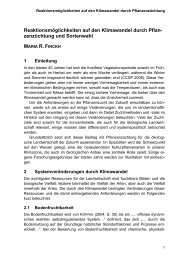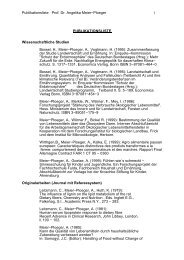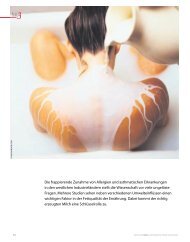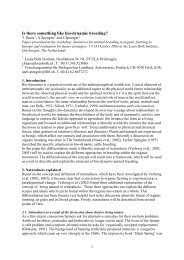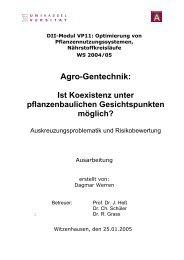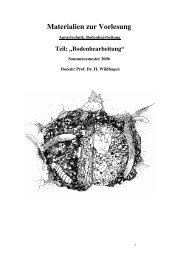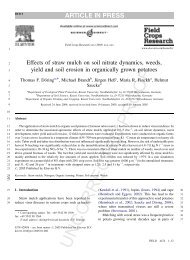Evidence for trichromacy in the green peach aphid, Myzus persicae ...
Evidence for trichromacy in the green peach aphid, Myzus persicae ...
Evidence for trichromacy in the green peach aphid, Myzus persicae ...
You also want an ePaper? Increase the reach of your titles
YUMPU automatically turns print PDFs into web optimized ePapers that Google loves.
3. Results<br />
3.1. Form of <strong>the</strong> electroret<strong>in</strong>ogram<br />
Fig. 2 shows a typical dark adapted ERG record<strong>in</strong>g<br />
elicited from M. <strong>persicae</strong>. It was found to be biphasic<br />
with a strong corneal negative on-response. The ERG<br />
read<strong>in</strong>g was taken as <strong>the</strong> voltage difference between <strong>the</strong><br />
pre-flash potential and <strong>the</strong> peak of <strong>the</strong> negative ERG<br />
component.<br />
3.2. Spectral sensitivity<br />
The spectral sensitivity of <strong>the</strong> dark adapted compound<br />
eye of M. <strong>persicae</strong> showed one peak of sensitivity<br />
at 530 nm (Fig. 3). No fur<strong>the</strong>r peak could be found <strong>in</strong><br />
Fig. 2. A typical ERG record<strong>in</strong>g from <strong>the</strong> <strong>green</strong> <strong>peach</strong> <strong>aphid</strong> at 530 nm<br />
light stimulus as measured by AC amplifier: A ¼ base-l<strong>in</strong>e potential,<br />
B ¼ receptor component of ERG,C ¼ off-response,D ¼ duration of<br />
stimulus.<br />
Fig. 3. Spectral sensitivity of <strong>the</strong> dark-adapted eye of alate M.<br />
<strong>persicae</strong>. Mean and standard error of 9 <strong>in</strong>dividuals (cont<strong>in</strong>uous l<strong>in</strong>e)<br />
and modelled sensitivity of a <strong>green</strong> receptor (lmax ¼ 527 nm,dotted<br />
l<strong>in</strong>e). For details of modell<strong>in</strong>g see text.<br />
ARTICLE IN PRESS<br />
S.M. Kirchner et al. / Journal of Insect Physiology 51 (2005) 1255–1260 1257<br />
Fig. 4. Spectral sensitivity of <strong>the</strong> white-adapted eye of alate M.<br />
<strong>persicae</strong>. Mean and standard error of 7 <strong>in</strong>dividuals.<br />
Fig. 5. Spectral sensitivity of <strong>the</strong> yellow-adapted eye of alate M.<br />
<strong>persicae</strong>. Mean and standard error of 7 <strong>in</strong>dividuals.<br />
<strong>the</strong> UV (320–400 nm). In <strong>the</strong> red region (620–640 nm)<br />
sensitivity was small (o8%). A dist<strong>in</strong>ct shoulder was<br />
observed <strong>in</strong> <strong>the</strong> sensitivity curve between 500 and<br />
510 nm.<br />
When <strong>the</strong> eye was tested <strong>in</strong> <strong>the</strong> presence of adapt<strong>in</strong>g<br />
lights,<strong>the</strong> spectral sensitivity function showed two<br />
fur<strong>the</strong>r peaks (Figs. 4 and 5). A UV-sensitive component<br />
with a maximum sensitivity <strong>in</strong> <strong>the</strong> region 330–340 nm<br />
appeared when <strong>the</strong> eye was white- or yellow-adapted. In<br />
addition,<strong>in</strong> presence of yellow adapt<strong>in</strong>g light a blue–<br />
<strong>green</strong>-sensitive component occurred with a maximum<br />
sensitivity at 490 nm (Fig. 5).<br />
3.3. Fitt<strong>in</strong>g a nomogram<br />
The exponential function<br />
a ¼ A exp½ a0x 2 ð1 þ a1xÞŠ



